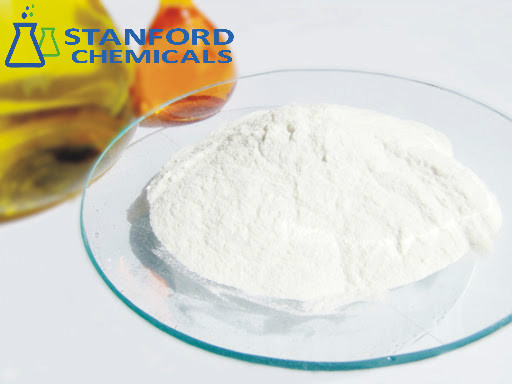Synonyms: Provitamin B5, D-Panthenol, DL-Panthenol, Dexpanthenol, Alcoholic Vitamin B5
The post 070-000-242 Panthenol appeared first on Stanford Chemicals.
]]>Panthenol comes from vitamin B5 and is a moisturizing compound. It can come from either animal or plant sources. Panthenol can be found in the ingredients in hair conditioners or body wash. Panthenol is used commonly in skincare and cosmetic products. Panthenol comes from pantothenic acid.
Panthenol Specification
| Product Name | INCI Name | CAS Number | Properties | Usage Level |
| FM-proVB5 | DL-Panthenol | 16485-10-2 | Moisturizer,
wound healing, anti-inflammatory. |
0.5-5.0% |
| Panthenol | 81-13-0 | Moisturizer,
wound healing, anti-inflammatory. |
0.5-5.0% |
Benefits of Panthenol
- Moisturizing: Panthenol moisturizes very effectively, deep into the skin, wherein it gets converted to Vitamin B5 inside the cells, further helping the skin to retain its moisture and helping to improve skin barrier function.
- Regenerating Skin: It can be used to rev up the proliferative process of skin cells and accelerate wound healing, hence it is generally utilized in the treatment of dry, sensitive, and injured skin to soothe dryness and inflammation.
- Smoothing-anti-inflammatory action: panthenol soothes the skin, thereby removing irritation and erythema and reducing the degree of burns after sun exposure.
- Improves Shine and Strength of Hair: This ingredient is used in hair care, especially because Panthenol permeates the interior of the hair to improve softness, shine, and elasticity while reducing breakage.
- Mechanism of Antioxidant Action: It acts against free radicals and thus minimizes the damage to skin and hair.
Applications of Panthenol
- skincare products
- Hair conditioners
- After-sun repair products
The post 070-000-242 Panthenol appeared first on Stanford Chemicals.
]]>- Type: Vitamins
- CAS No:98-92-0
- Qty in 20' FCL:0MT
- Min. Order:500KG
- QC: HACCP, KOSHER, HALAL, ISO, SGS, UKAS
- Packaging: Provide Neutral Packaging
Niacinamide (Vitamin B3) has a wide range of functions and is commonly used in skincare, food, and animal feed.
The post 040-000-155 Nicotinamide, Vitamin B3, CAS 98-92-0 appeared first on Stanford Chemicals.
]]>| Product Name | Nicotinamide |
| CAS Registry Number | 98-92-0 |
| Molecular Formula | C6H6N2O |
| Molecular Weight | 122.12 |
| Purity | 99% |
| Appearance | White powder |
| Shelf life | 2 years |
| Functions | Treat acne, and skin cancer, help with the digestive system, and decrease blood pressure |
Description of Nicotinamide
Nicotinamide is a water-soluble form of vitamin B3 or niacin. It is made in the body by eating niacin-rich foods such as fish, poultry, nuts, legumes, eggs, and cereal grains. Nicotinamide supplements are used to treat skin conditions and niacin deficiencies.
Solubility:1g of the product dissolves in 2 ml of water, 1.5 ml of ethanol, and about 10 ml of glycerol. Soluble in acetone, amyl alcohol, chloroform, propylene glycol, and butanol. Practically insoluble in ether and benzene.

Functions of Nicotinamide
Nicotinamide is an important part of the coenzyme Ⅰ and coenzyme Ⅱ in the human and animal body, involved in lipid metabolism, tissue respiration, and carbohydrate oxidation during the process of anaerobic decomposition. It’s mainly used in the skin care, medicine, food, and feed additives fields.
In skin care products, its main functions are:
- Helps reduce redness, inflammation, and acne
- Brightening and Spot Reduction, inhibiting melanin transfer, fading dark spots, and acne scars
- Minimizes Pores
- Stimulates collagen production, reducing fine lines and wrinkles
- Locks in moisture, and reduces water loss
- Antioxidant Protection, neutralizes free radicals
In animal feed additives, the main functions are:
- To prevent skin lesions and digestive diseases;
- Promote animal growth;
- Improve egg production and hatching rate;
- Ensure good feather growth;
- Treat mucosal inflammation and ulceration;
- Prevent livestock and poultry persons
In medicine and food additives, its main functions are:
- To prevent skin lesions and digestive diseases;
- To promote participation in the body of material and energy metabolism, to promote human growth and development;
- To treat a variety of mucosal inflammation and ulcers with other drugs;
- Strong vasodilator effect, to improve the blood supply to the body function, feature a favorable effect on cerebral thrombosis, coronary heart disease, hyperlipidemia, and so on;
- To treat nicotinic acid, nicotinamide deficiency caused by its long-term medicament of isonicotinic acid hydrazine and analogs
Applications of Nicotinamide
- Raw materials of drugs
- Skincare products
Reference:
- “Niacinamide Use During Pregnancy”. Drugs.com. Archived from the original on 30 December 2016. Retrieved 29 December 2016.
- Bender DA (2003). Nutritional Biochemistry of the Vitamins. Cambridge University Press. p. 203. ISBN 978-1-139-43773-8. Archived from the original on 30 December 2016.
- Williams AC, Cartwright LS, Ramsden DB (March 2005). “Parkinson’s disease: the first common neurological disease due to auto-intoxication?”. QJM. 98 (3): 215–26. doi:10.1093/qjmed/hci027
| ITEM | STANDARD |
| Assay.% | 98.5-101.5 (Hplc) |
| Identification a | Conform (Ir) |
| Identification b (Ratio:a245/a262) | 0.63-0.67 (Uv) |
| Melting Range ℃ | 128-131 |
| Loss On Drying % | =< 0.5 (Silica Gel Drier) |
| Residue On Ignition % | =< 0.1( High Temperature Ignition) |
| Heavy Metals % | =<0.003 (Colorimetry) |
| Readily Carbonizable Substances | Conform (Colorimetry) |
The post 040-000-155 Nicotinamide, Vitamin B3, CAS 98-92-0 appeared first on Stanford Chemicals.
]]>